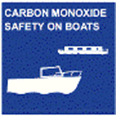May 13, 2014
180x180.jpg) |
Investigations start following the death of two people from CO poisoning.
“Each year boaters die or are made seriously ill from carbon monoxide (CO) poisoning – Boats are built to keep water out, but this also makes them good containers for gases and fumes.” |
When carbon-based, appliance and engine fuels, such as gas, LPG, coal, wood, paraffin, oil, petrol and diesel don’t burn completely, CO is produced.
CO build-up in the cabin can occur with one or a mix of these factors:
- with faulty, badly maintained, or misused appliances
- exhaust fumes from a boat’s engine or generator
- escaped flue gases from solid fuel stoves
- blocked ventilation or short supply of air – fuels need the right amount of oxygen to burn safely
10 tips to keep you alive!
For more detail read the information on the pages linked by the buttons on the left, or click next – How the silent killer works! or download the pdf booklet by clicking on the image on the right |
 |
Copyright belongs to the owners of the Boat Safety Scheme and CoGDEM jointly.
This information may be freely reproduced, except for advertising, endorsement or commercial purposes. Please acknowledge the source as Boat Safety Scheme & CoGDEM.






